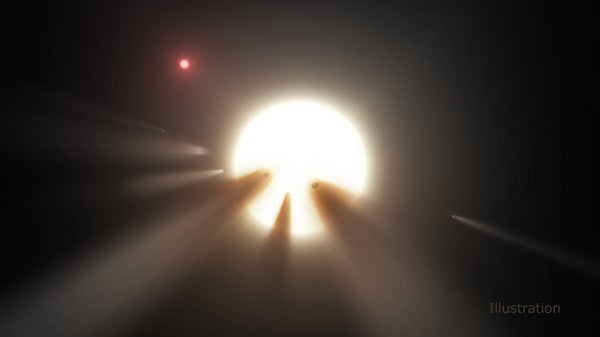The star often called the most mysterious in the galaxy has begun darkening again. Scientists are now rushing to watch the event with as many telescopes as they can muster to attempt to understand what is causing its bewildering fluctuations of light.
The star, called KIC 8462852 and nicknamed “Tabby's Star” after Yale University astronomer Tabetha “Tabby” Boyajian, first made news in 2015 when researchers discovered something odd about its light, whose strange brightenings and dimmings have even caused some to speculate it might host alien megastructures around it. The star is an otherwise-normal F type star—slightly larger and hotter than our sun—located about 1,480 light-years away from Earth in the constellation Cygnus, the Swan. When Boyajian and her colleagues analyzed data from NASA's Kepler space telescope, however, they found dozens of strange instances of KIC 8462852 darkening up to 22 percent.
These dimming events are far too substantial to be caused by planets crossing the face of the star, so scientists looked for other explanations. Some have even suggested that it might host signs of intelligent alien life—specifically, a Dyson sphere, a hypothetical megastructure built around a star to capture as much of its energy as possible to power an advanced civilization.
On supporting science journalism
If you're enjoying this article, consider supporting our award-winning journalism by subscribing. By purchasing a subscription you are helping to ensure the future of impactful stories about the discoveries and ideas shaping our world today.
In order to solve this mystery astronomers have been planning to analyze the full spectrum of light from Tabby's Star as it darkens via spectral measurements that split light into its constituent wavelengths. Because different materials absorb different wavelengths of light, spectra from the star could reveal what is causing its light fluctuations. “We’ve been waiting to catch another dip in light,” Jason Wright, an astronomer at The Pennsylvania State University, said in an online chat May 19.
Now scientists have discovered Tabby's Star is dimming again, and are racing to get as many telescopes as they can to watch it in as many wavelengths of light as possible, Wright said. “All week there's been some indication that something might be up,” he said. “Sure enough, at about 4 A.M. this morning [Pacific time], I got a phone call from Tabby [Boyajian] saying that Fairborn Observatory in Arizona had confirmed the star as 3 percent dimmer than it normally is. That's enough to say that it’s absolutely no statistical fluke, and we’ve now confirmed it with multiple observatories.”
Astronomers have proposed several possible reason’s for Tabby’s Star’s strange behavior, and each would create a different spectral signature. If clouds of dust are causing the dimming, they usually absorb bluer wavelengths of light, making stars look redder whereas comets passing close to a star would heat up and emit infrared light, Wright said. If interstellar clouds of gas are responsible, those are usually rich in sodium, hydrogen and calcium. And if the dimming is a phenomenon intrinsic to Tabby's Star itself, the spectra will show no signs that anything is absorbing the star's light. If an alien megastructure is the cause, it is difficult to predict what it might look like—if it is solid, “we might see the star getting dimmer overall,” Wright said.
In 2015 Boyajian and her colleagues predicted a dimming event might happen in May 2017. Based on the Kepler data, they suggested dimming of Tabby's Star might follow a roughly 750-day cycle. “It’s right on schedule,” Wright said. Boyajian herself demurred as to the accuracy of the estimate, noting “the prediction was a long shot—we cast a net of several hundred days.”
Among the telescopes Wright said researchers now hope to use to catch this dimming event in the act:
—The Green Bank Telescope in West Virginia, the world's largest fully steerable radio telescope
—The Automated Planet Finder at Lick Observatory near San Jose, Calif., a robotic optical telescope
—Both telescopes at the Keck Observatory in Hawaii, which operate in optical and near-infrared wavelengths
—The MMT Observatory in Arizona, an optical telescope
—NASA's Swift Gamma-Ray Burst Mission, which operates in gamma ray, x-ray, ultraviolet and optical wavelengths
‑Las Cumbres Observatory, a worldwide network of robotic optical telescopes
—Fairborn Observatory in Arizona, which operates in optical wavelengths
—The Large Binocular Telescope in Arizona, which operates in optical and near-infrared wavelengths
—The Hobby–Eberly Telescope in Texas, an optical telescope
“Our plan is to observe the star in as many wavelengths as we can,” Wright said. “This could be the weekend that we take the data that solves the puzzle.” Even more telescopes may also join in. “It's been a crazy 18 hours, and it’s going to be a really exciting weekend,” he said.
It remains unknown how long this dimming might last. “Most dips in the Kepler data take two to seven days,” Wright said. “So if this is a deep dip, it might be going on for a week. If it’s a shallow dip, it could be gone soon. Hopefully it’s a deep dip.” The data from Kepler does suggest such dimming events happen in clusters.
“This could just be the beginning,” Wright added.
